Armand Jean du Plessis
Saturday, June 16, 2007
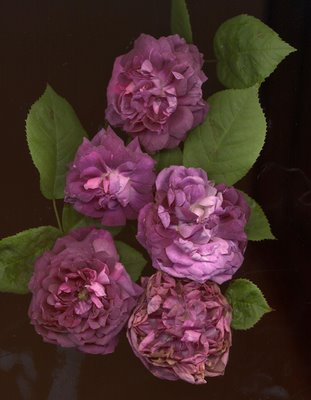 I pointed at the purple Gallica in my garden and told Rebecca yesterday that it was Rosa 'Cardinal de Richelieu'. Her answering question, "Who was he? Is he dead?" means that this afternoon Lauren, Rebecca and I are going to watch George Sidney's 1948 The Three Musketeers. In spite of everything that has been said and written about the sophistication of director Richard Lester's subsequent versions of the Alexandre Dumas novels, this Technicolor Hollywood production is my fave. 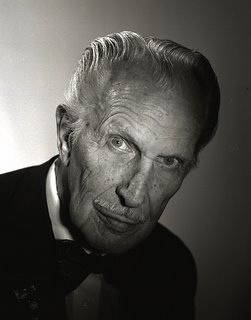 Nobody could possibly out do Vincent Price as the villanous cardinal (made villanous by Dumas). Gene Kelly is a delight as the handsome young fourth musketeer. But the treasure of this film is Lana Turner as Milady. I would affirm that if there is no protagonist in literature with fewer redeeming qualities than Milady. I would have to search in Cormac McCarthy's Blood Meridian for a an equal match. Lana Turner plays the role so well that in the end (I was 10 when I saw this film) I almost cheered as I imagined her head being chopped off by the Executioner of Lyon. Lana Turner was never more beautiful. As much as the bra was one of many anachronisms of the film, I don't think an anachronism was ever better served. This purple Gallica (with an extremely sweet old rose scent) in my garden was hybridized in 1840, 200 years after the Cardinal's death. There are conflicting opinions if M. Laffay of Bellevue, France or the Dutchman Van Sian should get the credit for this rose that sometimes gets so close to being blue as it fades with age. In my scan here you can see a spent bloom on the bottom right. That a rose, like so many others steeped in history, can help to make a Saturday with my granddaughters an excuse (with no guilt) for such fun as sitting down to watch one of my favourite films, has to be all the rationale needed to grow them.
Bars, Drinking, My Father & Les Wiseman Remembers Motorhead
Friday, June 15, 2007
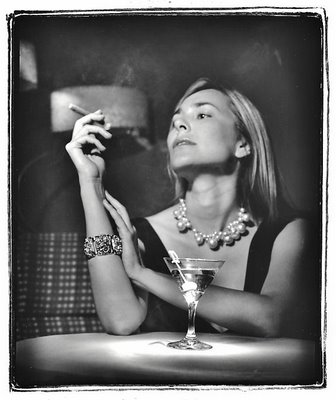
I would sit at the bar and Jorge, the Mexican barman would smile with a, "Que tal," and place a large glass of soda water in front of me. This was the Marble Arch Hotel, which had a stripper joint. The room was L-shaped. From my vantage point I could barely see the talent on stage. It was here that I pretended that I was Humphrey Bogart (Jorge didn't even have to ask me, "The usual?") in one of his early movies.
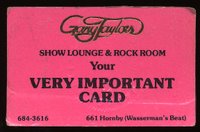
I could go to this bar, or the Drake, the Number 5 and Gary Taylor's and never have to pay for a drink even though my favourite was always soda water. It was at the Marble Arch with Jorge where I would glean information of Vancouver's underworld, a world that few ever read about in the newspapers.
Recently my youngest daughter Hilary reminded me (I was trying to explain to her the importance of culture) that it was not always so with me.
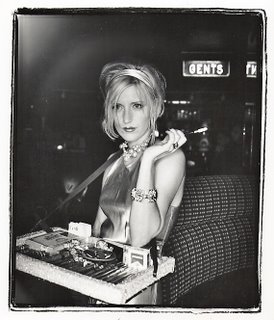
"You should get down from your culture high horse Papi. I remember when you used to go to listen to punk bands in bars with Les Wiseman and drank beer while Ale (my oldest daughter) and I were home watching TV." I tried to deny that I ever drank beer. But Ale did remind me that there were a few times (she remembers only two) where I arrived home late and made noisy use of the toilet.
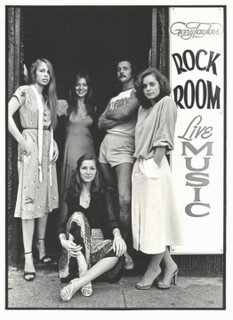
My friend John Lekich could write and has written beautiful romantic pieces on the lore, culture and mystique of good bars. In fact the photograph of Jim Byrnes having a chat with the barman of Gerrard's is at a place (never a joint for John) that is John's favourite bar of Vancouver.
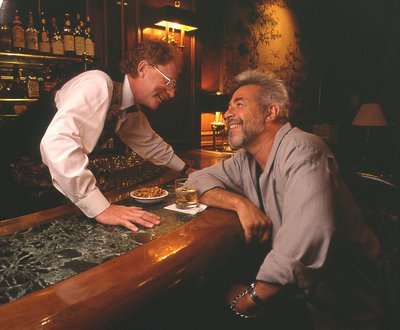
For a long time I attempted to live this lore of the bar with Les Wiseman but I could never get past the two beers that either triggered a migraine or nausea. But I learned plenty from Les. I became a musical snob and with Les I have had drinks with such musical stars as Sting and Lenny Kaye to Art Bergmann. It was with the latter that I remember once going to the Number 5 where at the time they had a most agressive waitress who asked us if we wanted more beer. We told her we had no more money. She said, "Look in your pockets and scrounge some change." We did. We put the coins on the table. She scooped them up and then placed a pint on the table and gave us two extra glasses. "Share that," she said and was gone.
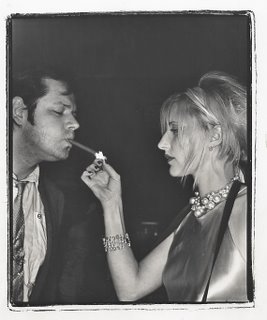
I remember the first time I got drunk. I was a boarder at St Edward's High School at Austin, Texas and I was in grade 11. My room mate, Maurice Badeaux was out on a date on a Saturday night. He kept a bottle of bourbon in his desk. I removed it and drank up and then got in bed to see what would happen. It was rapid oblivion and all I remember was being pulled to the floor and then kicked in the ribs by an irate Maurice, " You SOB, you drank all my liquor!" I can safely say that I got drunk maybe four more times in my life and I remember the circumstances for each case of which I will not bore you here. But I do remember the first bar I ever entered.
When I was 9, I had my first communion at the Nuestra Señora del Carmen chapel, around the corner on Roque Pérez in Buenos Aires. When the nuns came to collect our contributions, my father who was drunk, placed a package of Volpi, tangerine flavoured lozenges in the basket. I was ashamed. A few months later my father, George, voluntarily left the house. He would come to visit twice a month. In one of those visits he took me to Schubert House on Rivera Street. That is when I first got a whiff of that smell that defined all bars from the most sophisticated to the least. I remember going up a spiral staircase on to the upper floor. A pianist and violinist were playing a tango. My father proudly introduced me to them. I was so blond then, that the pianist told my father, “Your son looks German.” My mother was furious with George when she found out he had taken me to a bar. I didn’t see him for a long time. Of all of my father’s visits I remember best when he took me to the General Paz Theater on Cabildo Street to see Beau Geste with Gary Cooper and Ray Milland. It was only recently that I saw Ray Milland in Billy Wilder's The Lost Weekend with horror. The movie brought memories of my childhood. My father was an alcoholic who came from a family of alcoholics. My first cousin, Rollo Barber (who had a fondness for directing symphonic music played on his record player, much in the same way that others play air guitar) could hold a lot of liquor. It is because of this family history that I have never really enjoyed bars. But circumstances have made me go to many bars and there are quite a few memories that are pleasant.
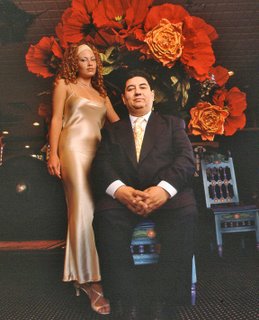
I used to frequent Ferydoun Manavi's Uforia, across from the Gerrard Bar on Burrard. Manavi, an Iranian, did not drink but had Vancouver's finest assortments of single malt Scotch. He often offered me ice-cold juice of pressed pomegranates which we would sip while admiring Ona Grauer's charms. Ona, seen here with Freddy (as all called Manavi) worked behind the bar.
Perhaps the most pleasant of all memories involved seeing the look on my friend Sean Rossiter's face. I was assigned by Equity Magazine to take photographs of exotic dancers getting ready in the dressing room of the Number 5. The article je was called Sex Sells. Once I had finished I came down with my equipment, assisted in this task by one of the most beautiful dancers of the day. I was spotted by Sean Rossiter who has never forgotten this incident.
In many of those bars, while I only drank water I still had conversations with many friends. In the photograph here with the exotic dancer as background at the Marble Arch I am sharing a table with Paul Wilson Brown, a musician and intellectual of note.
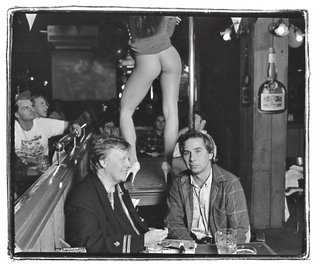
The language of drinking makes me think of some of the differences between the languages themselves. While it is one for the road in English in Spanish we say, "la del estribo," which includes the idea of finishing the last of your drink as you place your foot on the stirrup (estribo) of your horse. Let's have a drink usually means just that. In Argentina a "copetín" (a little wine glass) means a drink served with finger food. A beer in Mexico is a "cheve" which somehow evokes the sound of the z sounding c of cerveza.
A bar is a bar and only John Lekich would beg to differ as a good bar transcends all definitions. My friend Les Wiseman has risen to the occasion (on demand and with no lead time) to explain to us that perhaps a bar can even be a hotel room at the Holiday Inn on Howe Street before 9 am. Here is what he says:
Motorhead
Wiseman
AW-H mentioned in a phone call that he was blogging about drinking with celebrities. I immediately broke in and said you must mention the time with Motorhead and started rambling on the salient points of our lubricious intercourse with the kings of metal.
Scene: We walk into the hotel room and there are Lemmy and Philthy Phil. Lemmy with full wartage; Phil spiked and moustachioed. As we go to shake hands, we notice that our shoes are splopping through the carpet. What the hell happened here? Lemmy says, “Oh, an ice bucket got overturned and we never bothered to clean it up.” Must have been a heck of an ice bucket, about six square feet was underwater. Then Lem cracks a quart of Smirnoff and puts a couple fingers of orange juice in some tall tumblers and fills the rest with vodka. Throughout the interview, Lem keeps topping up the drinks, though the orange juice is never touched again until we are pulling on about eight inches of relatively clear fluid. I mention that it seems a touch early in the day of the gig to be hitting it with such enthusiasm. Phil pipes up, “We’re alcoholics, this is nothing for us.”
When we are joined by Robbo Robertson, the former Thin Lizzy guitarist who was replacing the departed Fast Eddie Clarke on the Another Perfect Day tour, he was completely out of sync with the black clothing and facial hair of Lem and Phil. He was also noticeably suffering the effects of the previous night, to which the others were conditioned and showed no such effects.
I asked what sort of groupies Motorhead got. Lem opened the door to an adjoining room and called for a young lady to come in. She was rail thin and stringy haired, mumbling incoherently. Lem nodded his head to her. “She’s from Philadelphia. She has no idea what city she’s in or where we are.” Then he motioned for her to remove herself and she shuffled back into the room and closed the door.
Robbo held his head and said nothing. Lem was effusive. Going on about amphetamine sulfate, his Canadian bust, and was egged on by Phil to talk about the fact that his father was a preacher and hence his longstanding dislike of organized religion. Phil pulled out a picture of his girlfriend, showed it to me. She was an ethereal type with a resemblance to Kate Bush. Not the brassy metalhead babe one might assume. Phil got a bit maudlin about being away from her.
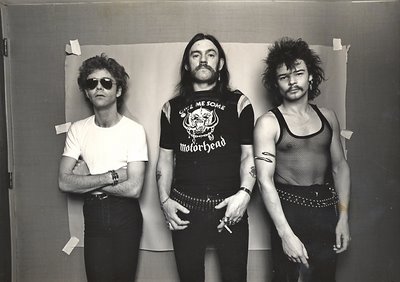
Time for A W-H to take the shot. The guys were great, though the black and whites likely do not show Robertson’s somewhat greenish hue. After the shoot, we all waddled off and it was only on trying to sight myself through the door that I realized maintaining my verticality might be a touch of a challenge for the next few hours.
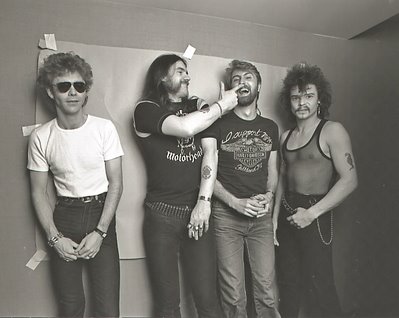
That night, the show at the Kerrisdale Arena was awesomely loud. The best acoustics were to be had at the MacDonalds a block away. Inside, the volume of air displaced by the speakers was large enough to press my clothing to my body. The band was tight and showed no deleterious effects from the breakfast libations. The only downside of the show was that, just before it began, news circulated that the greatest of rock crits, Lester Bangs had been found dead in his apartment. July 15, 1981.
L.M. Gottschalk & The Dutch Tilt
Thursday, June 14, 2007
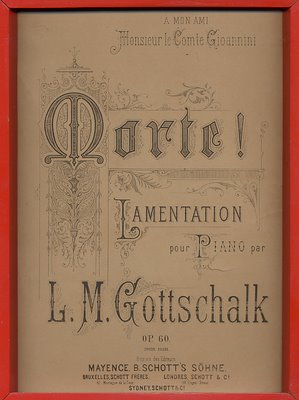
I have written a bit about American composer and piano virtuoso L.M. Gottschalk here and also about my mother's great aunt Buenaventura Galvez Puig. Pianists and piano composers are in my mind these days as I make it a point to put a CD of piano music in the car when I pick up Rebecca on Mondays to take her to her piano lessons. She always wants to know who is playing or the name of the composer. Of late we have been listening to Philip Glass playing his piano sonatas and Erik Satie. I am itching to buy some Gottschalk so she can make the connection through my grandmother Lolita (seen here at left with her aunt Buenaventura, right) to the piano playing heritage of my family.
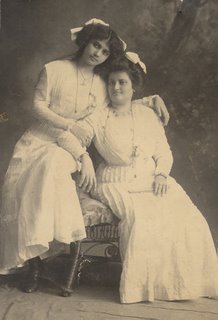
It was Buenaventura who must have given my mother her first piano lessons. This connection through Lolita is one that will fascinate Rebecca as she knows a lot about her even to my grandmother's fondness for dunking bread smeared with butter, peanut butter and jam in her café con leche.
Today I thought of another angle on L. M. Gottschalk. It is with an American born photographer, James La Bounty who has lived in Vancouver a few more years than my 30. I remember the first time I ever met him (27 years ago) at a Vancouver Magazine monthly contributors' party (we called them piss-ups). I was only then getting started as a magazine photographer and both James La Bounty and Howard Fry were nicely established. The former as an editorial photographer and the latter as a fashion photographer. I asked La Bounty what his home town of San Francisco was like. From his 6ft 4 inch vantage point he looked down on me and with a perfectly modulated FM radio voice he told me, "It's much like Vancouver except the streets go up and down and they have cable cars." He then turned around and moved away. It wasn't too long after that incident that my star began to rise in Vancouver Magazine as his began to decline. But La Bounty always got the lucrative annual reports and the travel assignments I rarely got. In my thirty years in Vancouver I have seen many photographers come and go. Some have stayed. But the only photographer who had and has a style all his own, a style I don't always understand but always admire, is La Bounty. If I ever felt that I had to compete for work by doing my best I have always had La Bounty in my mind.
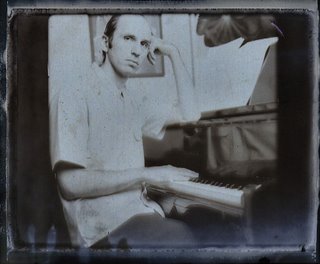 |
| Jim la Bounty by Alex W-H |
La Bounty was also first in photographic approaches that we adopted only later. He was the first to tilt the horizon (Dutch Tilt). He was also the first to state that he did not shoot straight portraits as his were conceptual portraits. I thought at the time that he was a bit too lofty in conceit to call his style that. I would now not think twice about stating that I shoot conceptual photographs.
If La Bounty didn't completely push me aside with his superior photographic talent it was in that he had a "tragic" flaw. This tragic flaw is only as I see it. I am sure he sees it differently. I have always thought myself an efficient commercial photographer, no more and no less. La Bounty had three facets. He was a commercial photographer, an art photographer and a composer pianist. My theory is that he channeled his energies three ways.
In my 30 plus years in Vancouver La Bounty is the only person who not only knew who Gottschalk was but also knew he had been born in New Orleans an that those two first initials stood for Louis Moreau.
As for Morte! the legend is that it was the last music Gottschalk (who was terminally ill) played at a concert in Rio de Janeiro on November 25, 1869. Actually it was the last complete work he ever played as he had begun his Tremolo when he had to stop.
Wednesday, June 13, 2007
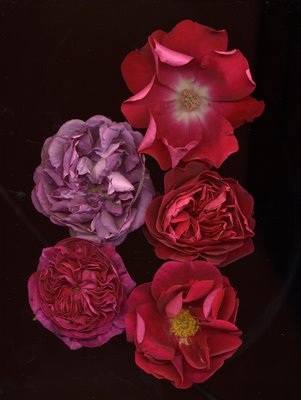
It was a Saturday sometime in 1957 when as a boarder at St. Edward's High School I went on my usual trip downtown (they let us go on Saturdays and Sundays). I did my usual round of the bookstores on 6th Street. There was no music then (record stores, of course), only bookstores that sold Frank Yerby, Frank G. Slaughter, and science fiction paperbacks, barber college and the danger that some spics might roll you if you looked too white. With my crisply starched and ironed khaki pants, my spit-shined long pointed black shoes and my freshly combed duck cut (I used Top Brass that came in a bright red tube) I was safe. From there I would go to the record store on Congress Avenue not far from the Austin movie theater and the Stephen F. Austin Hotel where I often had my favourite cherry-vanilla ice cream with bits of red cherries. At the record store I distinctly remember seeing the album cover The Dave Brubeck Quartet - Jazz Red Hot and Cool.This has to be one of the most appealing record albums ever made. I was not sophisticated enough to note that the photo (taken at the Basin Street Night Club in New York) was credited to Richard Avedon. But somehow I noted the explanation that the model was wearing Jazz Red Hot and Cool lipstick by Revlon!
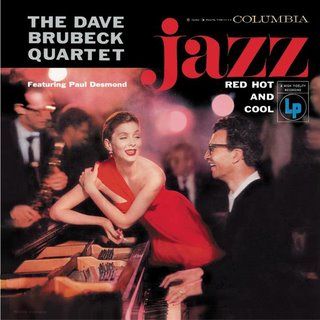
This is perhaps my favourite quiet Dave Brubeck with the exquisite The Duke. It also features Indiana a tune I played on my alto saxophone with the St Ed's band at basketball and football games. Our school had Brothers of Holy Cross (who teach at Notre Dame), so many of our boarders came from Indiana as they hoped to get good grades and then be accepted by the University of Notre Dame in Indiana that also had Brothers of e Holy Cross. For me Indiana awakens a nostalgia for sports that were really amateur, cheerleaders in bobby socks with a glimpse of panty here and there. Being cooped up at a boarding school for seven days (the only woman in sight was the black cook) had its pressures.
The above is all to explain that I learned to be partial to red thanks to that Avedon record cover and that recently I have become most interested in my red roses and even those that are purplish red. I am fascinated how some of these red roses fade with age to beautiful purples that shift to magenta, lilac and in some cases to a bluish tint with metallic overtones. The roses that do this are ancient Gallicas, moss roses and the like. The modern red hybrid tea roses don't do this. This is one more reason why I have none of them in my garden. All the roses, but one, featured in today's scan (but scanned last night) have intense scent. One of them is a modern "ancient" Gallica.
Top right: Rosa 'Dortmund', Kordes Germany 1955. This is a vigorous single climber with thorny branches but alas has no scent.
Middle left: Rosa 'William Lobb', Laffay France 1855. William Lobb is is a moss rose with lots of scent. The large flowers are a mixture of purple, grey, magenta and pink, slightly paler on the reverse.
Middle right: Rosa 'L.D. Braithwaite, Austin UK 1988. This English Rose is a cross between The Squire and Mary Rose. The colour is described by Peter Beales as being, "...rich glowing crimson with a hint of cerise." It has lots of perfume.
Bottom left: Rosa 'Charles de Mills' This is a rose of uncertain origin. It blooms only once (like the moss rose above) but it has intense perfume and a bloom that is flat that looks like someone sliced with a razor. Nobody knows who Charles de Mills was.
Bottom right: Rosa 'James Mason', Beales UK 1982. This rose is an anachronism as it is an ancient Gallica that was bred recently in honour of an actor who also happened to be a rosarian. The single bloom is scented. James Mason is not remontant.
Charles de Mills
Dave Brubeck
L.D. Braithwaite
Ian Davidson's Yves Klein
Monday, June 11, 2007
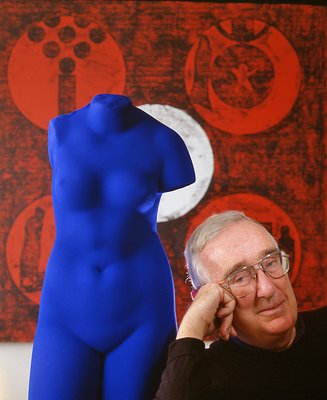 I first met architect Ian Davidson around 1985 and I photographed him in Yaletown in relation to a project he was involved which was 7 story office building his firm, Davidson & Johnston was going to build. It was to be the beginning of a the Yaletown we now know. I took the shot where Mainland ends at Davie. At the time the old Connaught bridge (the one that had wood instead of pavement in the middle) was being replaced by what we now call the Cambie Street Bridge. 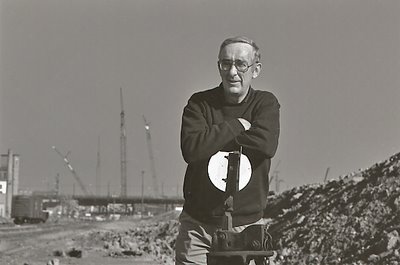 Yaletown, then, was surrounded by nothing and all those condos on Pacific Boulevard were yet to come. But some construction had begun in preparation for Expo 86. Two or three years later I found out that Davidson was a serious art collector. He was also a member of the board of the Vancouver Art Gallery. There are many who have said that Davidson and his pal Monty Clark of the Monty Clark Gallery could and yet can decide who sells well in Vancouver, who is a serious artist and who is not. In Davidson's apartment I was attracted by this Yves Klein torso. The intensity of the blue was dazzling. Davidson told me that Klein had patented it and called it International Klein Blue. I remember taking at least 35 slides trying to decide where to place Davidson in relation to the red painting behind him. I had second thoughts of the almost white space at the bottom left. When I raised my camera the white disappeared but something else bothered me. In the end I settled for this angle and I obtained many variations. But this one I like as Davidson's almost smile contrasts with the cool blue. It's one of my favourite portraits but few have ever seen it.
Jennifer Froese's & My Mother's Red Rebozo
When my mother traveled to Mexico from Argentina in 1952 she was given there a red rebozo. Its intense, rich red reminded me of the robe from that first Cinemascope production The Robe with Richard Burton and Jean Simmons. The robe was the robe of Jesus Christ. My mother's rebozo was made of rough cotton and the red came from a natural vegetable dye. I have treasured it all these years and I have often used it as a portrait prop.
When I met Jennifer Froese, a friend of Bif Naked, she seemed very sad. She was the very opposite of her friend. When she posed for me this sadness was evident but wonderful at the same time.
She revelead her tattoo and here you see but a glimpse of it, partly hidden by my mother's red Mexican rebozo.
Sunday, June 10, 2007
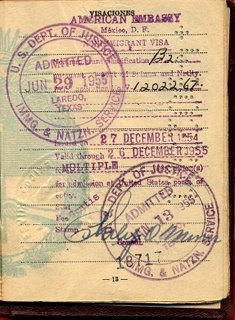 The houses were detached with large front lawns. Children were playing. There were no fences or walls between the houses. As a young boy living in Mexico, bardas and paredones (walls and big walls) were the rule. I had never seen anything like this. I saw red Flyer wagons and strange bicycles with thick tires. I am not sure if subsequent exposure to the Saturday Evening Post confused my memory. I am almost sure I saw a Dalmatian and a Cocker Spaniel running with the kids. This was Laredo, Texas, June 29, 1955 and I was 12 years old. My mother bought me a Revell plastic kit of what was a circa mid 50s Chevrolet truck. I was in heaven. It was my first venture into the United States of America. I have been an Ameriphile since. I had yet to note the significance that this first venture was through Texas. This first entry into the United States was the realization of a dream that had started in Buenos Aires through my mother's connection to Americans by virtue of her job at the local American Grammar and High School. We were lower middle class but as her son I had free tuition so I attended the grammar school from kindergarden onwards. It was in that school where I made friends with Americans and first discovered Bazooka and Double Bubble, Gene Autrey and Roy Rodgers cap pistols and those impossible to get Lee jeans. We Argentines were starved and obsessed for American products. I remember with an absolute certainty a huge ad for Cemento Portland in the Retiro train station that had in parenthesis (USA) after every mention of the product. It would have seemed that Argentines and Perón depended on this great product to go forward on those Five-Year-Plans. My mother brought stuff from school. I remember my first package of lime Jell-O, my first taste of a poppy seed bagel, and that Erector set that I received on Christmas made all my Argentine friends jealous. I had a distorted view of my mythical country. I remember showing pictures to my friend Mario Hertzberg of wide-shouldered norteamaricanos who lived on a an island called Columbia. This island was protected by a very large statue of a woman holding a torch. This confused idea of mine had come (I realize this now) from an article in Life magazine about Columbia University ( its football team) and its proximity to the Statue of Liberty since the university is in New York City. One of my mother's friends was the assistant (to the American Consul. The assistant and his wife would visit us in their baby blue 1950 Ford. When they parked this car at the front of my house I was the king of my Coghlan neighbourhood. That first entry into the US through Laredo was one of several other short visits that my mother and I made. To get our Mexican residency (we had moved from Buenos Aires in 1954) we needed to leave Mexico and come back. This archaic and expensive bureacratic method still lives on in many countries. While living in Nueva Rosita , Coahuila where my mother taught at the one room school house of the American Smelting and Refining Company school for the children of its engineers we made frequent visits to Eagle Pass (prounounced Eeglay Pass) by crossing from Piedras Negras, Coahuila. I remember most fondly the Eagle Pass Hotel that was decorated with Remington rifles and portraits of John Wayne. In Eagle Pass I sqandered $5.00 American Dollar bills (my special allowance) on Revell and Monogram plastic model kits. I had a huge collection. These visits and my subsequent 4 years at St. Edward's High School in Austin, Texas managed to erase whatever ideas I had about being either an Argentine or a Mexican. I became an American. I became an American because I chose to be one. I felt American and even to this day I can claim that part of me is American. When you are in an American school and you study civics, you learn the workings of the three branches of the American federal government and even the details on the differences between misdemeanors and a felony it is difficult to "fight" the system. 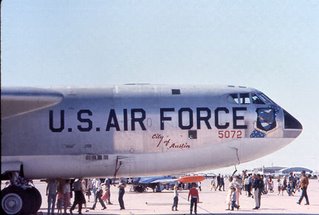 It was difficult to fight this system when I visited the nearby Bergstrom US Air Force Base and ran my hands on the sharp edge of a Lockheed F-104 Starfighter or gazed up on the gigantic tail of a Boeing B-52 Stratofortress. It is only today that I notice or remember its name, The City of Austin. 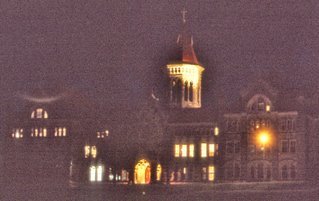 It was difficult not to feel American when I heard the F-101 Vodoos streak above our neo-Gothic main building knowing (so we had heard io on Radio KTCBC, now KLBJ!) that one of them had fired a rocket that had flown up the tailpipe of a Russian Mig in Korea and downed it in a flash. 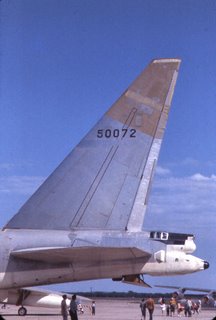 It was difficult not to feel pride in being an American when I saw our Catholic White Hope, Senator Kennedy debate Vice-President Richard Nixon on TV. On the Easter holidays of my first year at St. Ed's my mother had scraped up enough money to send me on a school-sponsored trip (we went in a rented Grehound Scenicruiser!) to Washington, DC. 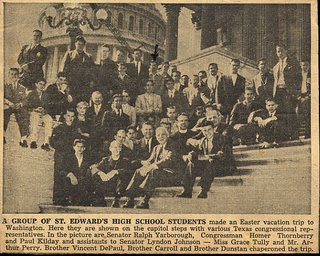 I have memory of shaking hands with a tall man with large hands and large ears. He gave me a card which I promptly threw away. It was a card that certified that I (my name was written on it) I had attended a hearing at the US Senate Chamber. It was signed by our Texas senator, Lyndon Johnson. The B of the LBJ was not to surface until John Kennedy became JFK. It was in DC where I bought my first serious camera, and Agfa Silette type 1 at a pawnshop. I asked for film and I remember that the druggist said, "Try Kodak Tri-X, it's the best film we carry." To this day, even though they have stopped the manufacture of many of my favourites, i shoot the film in from those familiar bright yellow and blue boxes. Looking back on this all as Rosemary and I prepare our July 15 trip with Rebecca to Mérida, Yucatán via Austin, Texas I can feel that this American part of me is a bit less American and lot more Texan. It was living and growing up in Texas, falling for my first sweatheart Judy Reyes that was so important in my becoming who I am today. Those long bus trips from Nueva Rosita to Austin, took me on Continental Trailways Flxible buses that passed through Texas towns like Carrizo Springs, Del Rio, Uvalde, Crystal City (the first US city with an elected official of Mexican heritage) on its way to San Antonio. There I would board one of those exceedingly handsome and magical Greyhound Scenicruisers that seemed to fly on the Texas concrete-made expressways (as Texans call freeways) which were part of President DwightD. Eisenhower's legacy to the US. These expressways started the American dependancy on the automobile. I remember that both Bing Crosby and Bob Hope appeared in large Life Magazine ads that trumpeted the advantages of concrete freeways. Those lonely (it was always sad to leave home after the Christmas holidays to head to the bleak, cold and rainy Austin winters) bus trips were through stark Texas landscape of mesquite and desert with the occasional flash floods that made dry river beds suddenly look like small oceans. I first became used to that Texas landscape, and then without knowing I absorbed it so that I now anticipate with tremendous pleasure being able to see it soon. Near Austin we will visit my friend Howard Houston and his wife Lynne. We will eat all kinds of Texas barbecue and Tex-Mex food. But principally we will visit our old St. Ed's and hug Brother Edwin Reggio CSC who was there with us and was a key element in our transition from boyhood into manhood. But he had nothing to do with the fact that today I am a Canadian citizen born in Buenos Aires who feels very Texan. I feel Texan enough to know that the US has had two Texas born presidents. That second one, the one you probably cannot remember, was born in Denison, Texas. That's Dwight David Eisenhower.
|































